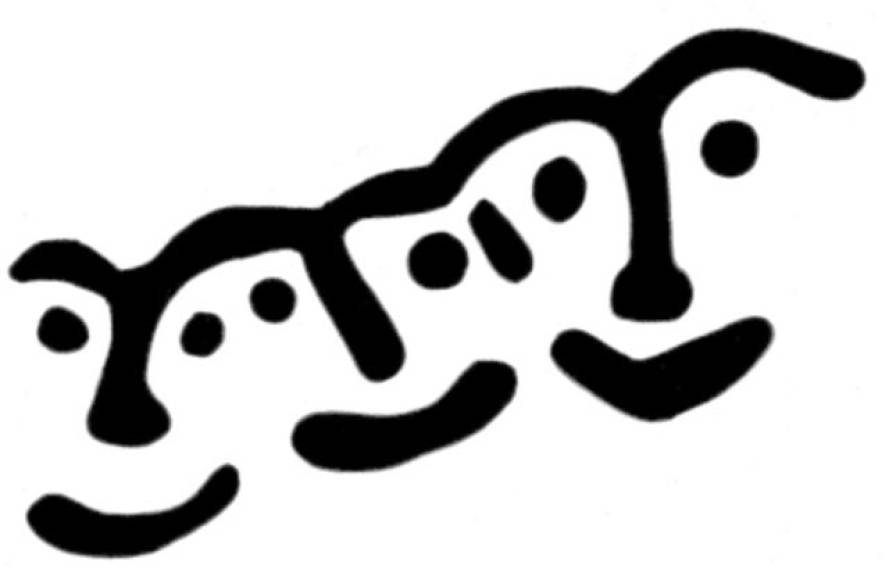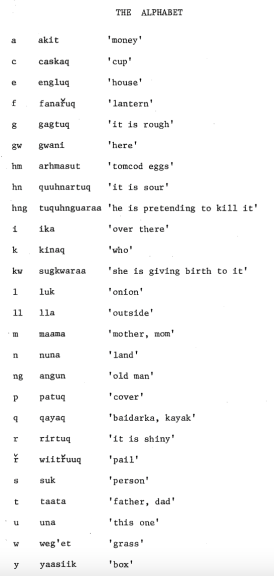Clerks Alutiiq Alphabet
Historically, the Alutiiq language was primarily a spoken language without a written form until European and American contact. There was some written communication in the form of pictographs and petroglyphs, but not an alphabetical form of written language. Recognizing the importance of preserving their unique linguistic heritage, Alutiiq tribal members collaborated with outsiders to develop a written form of their oral language. This endeavor aimed to safeguard their unique language, cultural practices, and ancestral traditions from the risk of being lost or diminished.
The following article has been provided by the Alutiiq Museum -
ALUTIIQ PICTOGRAPHS
Pictographs were used to write “notes” to other people using stick figures and other simple line drawings. These pictographs tell a story: 1) A man indicating a direction, 2) that he will be going by kayak, 3) sleeping for one night 4) at an inhabited island, then 5) traveling on to 6) an uninhabited island, 7) staying for two nights, 8) hunting, 9) for sea lion 10) with bow-and-arrow, and then 11) returning 12) to his home. From Hoffman (1882).

PETROGLYPHS

Petroglyphs are images and designs pecked into rock. Some are at least 1,000 years old and appear along Kodiak's coast in places like Afognak and Cape Alitak. While their exact function is not known, these images may be associated with whaling shamanism, storytelling, or territory marking.
Russian priests and Native students developed the first alphabetical form of Alutiiq in the early 1800s. These scholars used the Cyrillic alphabet to represent Alutiiq sounds. Remaining texts from this period include the Lord's Prayer (1816), a catechism (1847), a primer (1848), and a Gospel of St. Matthew (1848). As Dr. Lydia Black laments in "Forgotten Literacy," although this form of written Alutiiq was used throughout our homeland, it quickly faded after Americanization (Black 2001).
Dr. Jeff Leer developed the Alutiiq alphabet in use today, work that began in the 1970s (Counceller 2010). The alphabet for the Koniag dialect has 26 letters and is similar to the Yup’ik alphabet and writing system. The Alutiiq alphabet has undergone a number of minor modifications over the years, but has returned to the basic form introduced in Leer’s 1978 Kodiak Alutiiq Dictionary (Leer 1978).
This writing system is based on Roman alphabet characters, which do not always sound the same as English letters. There are also letters made up of two or even three Roman characters that are considered single letters, such as ll and hng. This alphabet and writing system are used in all Alutiiq Museum language materials, including the Alutiiq Word of the Week. The use of a unified writing system has been a central need for collaborative language efforts on Kodiak Island as the community strives to turn the tide on Alutiiq language loss.
REFERENCES:
Black, Lydia T. 2001 Forgotten Litteracy. In Looking Both Ways. A Crowell, A. Steffian, and G. Pullar (Eds.) Pp. 60-61. University of Alaska Press, Fairbanks.
Counceller, April Gale Laktonen 2010 Niugneliyukut (We Are Making New Words): A Community Philosophy of Language Revitalization. Doctoral dissertation, University of Alaska, Fairbanks.
Hoffman, W.J. 1882 Comparison Of Eskimo Pictographs With Those Of Other American Aborigines. in Transactions of the Anthropological Society, Pp. 128-146.
Leer, Jeff 1978 A Conversational Dictionary of Kodiak Alutiiq. Alaska Native Language Center, University of Alaska, Fairbanks.
Additional References:
Alutiiq language - This is an excellent source to discover words in the Alutiiq language. The resource allows you to hear words being said by an Alutiiq speaker, and explore how to use words in full sentences
